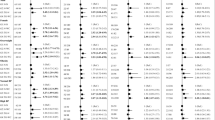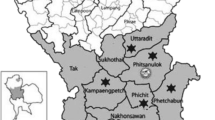Abstract
Purpose
The “hyper-triglyceridemic waist (HTW) phenotype” is relatively convenient to identify, acquired readily, and is inexpensive. We explored the relationship between the HTW phenotype and abdominal-fat accumulation in Chinese adults.
Methods
The study cohort comprised 195 adults divided into four groups according to triglyceride (TG) concentration and waist circumference (WC): normal (A), “hyper-TG” (B), “hyper-WC” (C) and the HTW phenotype (D). The abdominal-fat compartment was measured by magnetic resonance imaging. A 75-g oral glucose tolerance test (OGTT) was administered after an overnight fast. Clinical, anthropometric and laboratory data were analyzed.
Results
Individuals with the HTW phenotype had the highest WC, Conicity Index, waist:hip ratio and abdominal visceral fat (AVF) area, and the highest TG and uric-acid concentrations among the four groups. People with the HTW phenotype were older, had higher blood pressure than those with normal WC (groups A and B). In the OGTT, participants with the HTW phenotype had the highest insulin resistance and lowest insulin sensitivity. In binary logistic regression analysis, age, sex, Body Mass Index, high concentrations of density lipoprotein-cholesterol and low-density lipoprotein-cholesterol, and the HTW phenotype were independent risk factors for predicting AVF accumulation with a sensitivity of 81.08% and specificity of 90.91%.
Conclusions
Chinese adults with the HTW phenotype had the highest AVF area and insulin resistance, and were associated with higher blood pressure than individuals with normal WC. The HTW phenotype is a reliable marker for prediction of AVF accumulation associated with insulin resistance.
Level of evidence
IV.
Similar content being viewed by others
Data Availability
The datasets used and/or analyzed during the current study are available from the corresponding author on reasonable request.
References
Pouliot M-C, Després J-P, Nadeau A, Moorjani S, Prud’Homme D, Lupien PJ, Tremblay A, Bouchard C (1992) Visceral obesity in men: associations with glucose tolerance, plasma insulin, and lipoprotein levels. Diabetes 41(7):826–834. https://doi.org/10.2337/diab.41.7.826
Brisson D, Perron P, Guay SP, Gaudet D, Bouchard L (2010) The “hypertriglyceridemic waist” phenotype and glucose intolerance in pregnancy. CMAJ Can Med Assoc J 182(15):E722–E725. https://doi.org/10.1503/cmaj.100378
Egeland GM, Cao Z, Young TK (2011) Hypertriglyceridemic-waist phenotype and glucose intolerance among Canadian inuit: the international polar year inuit health survey for adults 2007–2008. CMAJ Can Med Assoc J 183(9):E553–E558. https://doi.org/10.1503/cmaj.101801
Du T, Sun X, Huo R, Yu X (2014) Visceral adiposity index, hypertriglyceridemic waist and risk of diabetes: the China Health and Nutrition Survey 2009. Int J Obes (Lond) 38(6):840–847. https://doi.org/10.1038/ijo.2013.181
Amato MC, Giordano C, Galia M, Criscimanna A, Vitabile S, Midiri M, Galluzzo A (2010) Visceral adiposity index: a reliable indicator of visceral fat function associated with cardiometabolic risk. Diabetes Care 33(4):920–922. https://doi.org/10.2337/dc09-1825
Lemieux I, Pascot A, Couillard C, Lamarche B, Tchernof A, Almeras N, Bergeron J, Gaudet D, Tremblay G, Prud’homme D, Nadeau A, Despres JP (2000) Hypertriglyceridemic waist: a marker of the atherogenic metabolic triad (hyperinsulinemia; hyperapolipoprotein B; small, dense LDL) in men? Circulation 102(2):179–184. https://doi.org/10.1161/01.CIR.102.2.179
Grundy SM, Neeland IJ, Turer AT, Vega GL (2013) Waist circumference as measure of abdominal fat compartments. J Obes 2013:454285. https://doi.org/10.1155/2013/454285
Tanko LB, Bagger YZ, Qin G, Alexandersen P, Larsen PJ, Christiansen C (2005) Enlarged waist combined with elevated triglycerides is a strong predictor of accelerated atherogenesis and related cardiovascular mortality in postmenopausal women. Circulation 111(15):1883–1890. https://doi.org/10.1161/01.cir.0000161801.65408.8d
Lemieux I, Poirier P, Bergeron J, Almeras N, Lamarche B, Cantin B, Dagenais GR, Despres JP (2007) Hypertriglyceridemic waist: a useful screening phenotype in preventive cardiology? Can J Cardiol 23(Suppl B):23b–31b. https://doi.org/10.1016/S0828-282X(07)71007-3
de Graaf FR, Schuijf JD, Scholte AJ, Djaberi R, van Velzen JE, Roos CJ, Kroft LJ, de Roos A, van der Wall EE, Wouter Jukema J, Despres JP, Bax JJ (2010) Usefulness of hypertriglyceridemic waist phenotype in type 2 diabetes mellitus to predict the presence of coronary artery disease as assessed by computed tomographic coronary angiography. Am J Cardiol 106(12):1747–1753. https://doi.org/10.1016/j.amjcard.2010.08.015
Blackburn P, Lemieux I, Lamarche B, Bergeron J, Perron P, Tremblay G, Gaudet D, Despres JP (2012) Hypertriglyceridemic waist: a simple clinical phenotype associated with coronary artery disease in women. Metab Clin Exp 61(1):56–64. https://doi.org/10.1016/j.metabol.2011.05.017
Sarrafzadegan N, Khosravi-Boroujeni H, Esmaillzadeh A, Sadeghi M, Rafieian-Kopaei M, Asgary S (2013) The association between hypertriglyceridemic waist phenotype, menopause, and cardiovascular risk factors. Arch Iran Med 16(3):161–166
Yang RF, Lin Z, Liu XY, Zhang G (2014) A clinical study of patients with coronary heart disease complicated with hypertriglyceridemic waist phenotype. Cell Biochem Biophys 70(1):289–293. https://doi.org/10.1007/s12013-014-9906-7
Moon BS, Park HJ, Lee MK, Jeon WS, Park SE, Park CY, Lee WY, Oh KW, Park SW, Rhee EJ (2015) Increased association of coronary artery calcification in apparently healthy Korean adults with hypertriglyceridemic waist phenotype: the Kangbuk Samsung Health Study. Int J Cardiol 194:78–82. https://doi.org/10.1016/j.ijcard.2015.05.104
Kelishadi R, Jamshidi F, Qorbani M, Motlagh ME, Heshmat R, Ardalan G, Hovsepian S (2016) Association of hypertriglyceridemic-waist phenotype with liver enzymes and cardiometabolic risk factors in adolescents: the CASPIAN-III study. Jornal de pediatria 92(5):512–520. https://doi.org/10.1016/j.jped.2015.12.009
Blackburn P, Lamarche B, Couillard C, Pascot A, Bergeron N, Prud’homme D, Tremblay A, Bergeron J, Lemieux I, Despres JP (2003) Postprandial hyperlipidemia: another correlate of the “hypertriglyceridemic waist” phenotype in men. Atherosclerosis 171(2):327–336. https://doi.org/10.1016/j.atherosclerosis.2003.06.001
Esmaillzadeh A, Mirmiran P, Azizi F (2006) Clustering of metabolic abnormalities in adolescents with the hypertriglyceridemic waist phenotype. Am J Clin Nutr 83(1):36–46. https://doi.org/10.1093/ajcn/83.1.36
Gazi IF, Filippatos TD, Tsimihodimos V, Saougos VG, Liberopoulos EN, Mikhailidis DP, Tselepis AD, Elisaf M (2006) The hypertriglyceridemic waist phenotype is a predictor of elevated levels of small, dense LDL cholesterol. Lipids 41(7):647–654. https://doi.org/10.1007/s11745-006-5015-8
Sam S, Haffner S, Davidson MH, D’Agostino RB, Feinstein S, Kondos G, Perez A, Mazzone T (2009) Hypertriglyceridemic waist phenotype predicts increased visceral fat in subjects with type 2 diabetes. Diabetes Care 32(10):1916–1920. https://doi.org/10.2337/dc09-0412
Yu D, Huang J, Hu D, Chen J, Cao J, Li J (2010) Is an appropriate cutoff of hypertriglyceridemic waist designated for type 2 diabetes among Chinese adults? Clin Nutr (Edinburgh. Scotland) 29(2):192–198. https://doi.org/10.1016/j.clnu.2009.06.008
Cunha de Oliveira C, Carneiro Roriz AK, Eickemberg M, Barreto Medeiros JM, Barbosa Ramos L (2014) Hypertriglyceridemic waist phenotype: association with metabolic disorders and visceral fat in adults. Nutricion Hospitalaria 30(1):25–31. https://doi.org/10.3305/nh.2014.30.1.7411
Ren Y, Zhang M, Zhao J, Wang C, Luo X, Zhang J, Zhu T, Li X, Yin L, Pang C, Feng T, Wang B, Zhang L, Li L, Yang X, Zhang H, Hu D (2016) Association of the hypertriglyceridemic waist phenotype and type 2 diabetes mellitus among adults in China. J Diabetes Investig 7(5):689–694. https://doi.org/10.1111/jdi.12489
Wang R, Lu Q, Feng J, Yin F, Qin C, Liu B, Liu Y, Liu X (2012) Coexistence of non-alcoholic fatty liver disease with elevated alanine aminotransferase is associated with insulin resistance in young Han males. Endocrine 41(1):70–75. https://doi.org/10.1007/s12020-011-9511-0
Thomas EL, Bell JD (2003) Influence of undersampling on magnetic resonance imaging measurements of intra-abdominal adipose tissue. Int J Obes Relat Metab Disord 27(2):211–218. https://doi.org/10.1038/sj.ijo.802229
Zhang Y, Chen TW, Zhang XM, Wang YX, Chi XX, Li XH, Gao XF, Ji YF (2014) Abdominal regional fat distribution on MRI correlates with cholecystolithiasis. PLoS One 9(10):e109776. https://doi.org/10.1371/journal.pone.0109776
Haack RL, Horta BL, Gigante DP, Barros FC, Oliveira I, Silveira VM (2013) The hypertriglyceridemic waist phenotype in young adults from the Southern Region of Brazil. Cadernos de saude publica 29(5):999–1007. https://doi.org/10.1590/S0102-311X2013000500017
Arsenault BJ, Lemieux I, Despres JP, Wareham NJ, Kastelein JJ, Khaw KT, Boekholdt SM (2010) The hypertriglyceridemic-waist phenotype and the risk of coronary artery disease: results from the EPIC-Norfolk prospective population study. CMAJ Can Med Assoc J 182(13):1427–1432. https://doi.org/10.1503/cmaj.091276
St-Pierre J, Lemieux I, Perron P, Brisson D, Santure M, Vohl MC, Despres JP, Gaudet D (2007) Relation of the “hypertriglyceridemic waist” phenotype to earlier manifestations of coronary artery disease in patients with glucose intolerance and type 2 diabetes mellitus. Am J Cardiol 99(3):369–373. https://doi.org/10.1016/j.amjcard.2006.08.041
Lim U, Ernst T, Buchthal SD, Latch M, Albright CL, Wilkens LR, Kolonel LN, Murphy SP, Chang L, Novotny R, Le Marchand L (2011) Asian women have greater abdominal and visceral adiposity than Caucasian women with similar body mass index. Nutr Diabetes 1:e6. https://doi.org/10.1038/nutd.2011.2
Acknowledgements
We thank Arshad Makhdum, PhD, from Liwen Bianji, Edanz Group China (http://www.liwenbianji.cn/ac), for editing the English text of a draft of this manuscript.
Author information
Authors and Affiliations
Corresponding author
Ethics declarations
Conflict of interest
On behalf of all authors, the corresponding author states that there is no conflict of interest.
Ethical approval
This study was approved by the Committee of Ethics in Research of the First Hospital of Qinhuangdao (2016C005).
Informed consent
All participants provided their written informed consent to participate in this study, after approval of the process by the ethics committee.
Additional information
Publisher’s Note
Springer Nature remains neutral with regard to jurisdictional claims in published maps and institutional affiliations.
Rights and permissions
About this article
Cite this article
Tian, YM., Ma, N., Jia, XJ. et al. The “hyper-triglyceridemic waist phenotype” is a reliable marker for prediction of accumulation of abdominal visceral fat in Chinese adults. Eat Weight Disord 25, 719–726 (2020). https://doi.org/10.1007/s40519-019-00677-w
Received:
Accepted:
Published:
Issue Date:
DOI: https://doi.org/10.1007/s40519-019-00677-w




